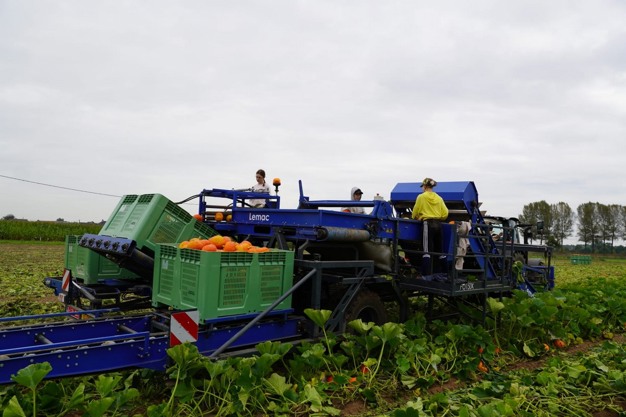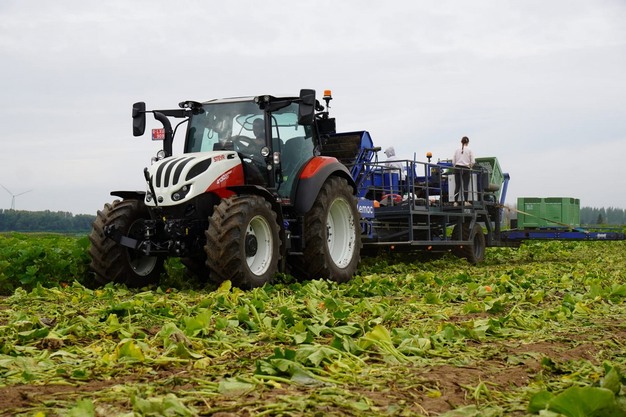With the end of summer in sight, the switch to autumn produce is also slowly but surely taking place. Temperatures are not yet showing, but stone fruit and cherries are being traded in for leeks and cauliflower. And of course, pumpkin, which is currently being harvested in abundance on the growing farm of Jeroen De Ridder, who has adopted the nickname Jeroen Pompoen, which translated to Jeroen Pumpkin in Dutch. "We started a bit later than usual and the quality is variable. We see areas with very good pumpkins, but also a lot that we are not completely satisfied with," the grower from Sint-Gillis-Waas tells us.

Jeroen runs a cultivation farm here with his wife Ilse where he grows pumpkins on some 64 hectares. His passion for pumpkins started early on and he now grows some 25 varieties and has even set up a special plot for experimenting with dozens of different varieties. "However, most of our acreage consists of Hokkaido and bottle pumpkins, but we are also working a lot with varieties like Kobucha, spaghetti, and grey pumpkins," he explains. "What we are harvesting now is the Hokkaido, but it remains to be seen exactly what we will get in terms of volumes. The bulk was only sown at the end of June, so we are still waiting for that. If weather conditions cooperate, the Hokkaido will be fine."
"On the bottle pumpkins, however, we will have to wait a while," Jeroen continues. "These were planted very late, so they are only now starting to get a bit of color. Here, too, a lot will depend on the weather conditions in the coming period. Night frost in particular could be a game-changer here. It doesn't look like it now, but soon it could get very cold. The Hokkaido will not suffer that much, but in the case of the bottle squash, it could have major consequences. But let's not assume that for now. The advantage is that we have a lot better varieties in northern Europe today than, say, 10 years ago, making them more resistant to any extremes."

Jeroen and Ilse De Ridden - Heyrman
Shortages towards the end of the season
So the quality remains to be seen, but Jeroen is adamant about the volumes. "There too, it could still be better, but I expect it's going to be less than other years. That's not just in Belgium, but I hear it from all over Europe. Everyone talks of variable yields. Some fields are good and some are very bad. It's pie in the sky, but I dare say we can expect shortages towards the end of the season."
The season at Jeroen Pompoen normally runs through March. "Only usually we sell out towards the end of January and this year we will not make it later. Of course, that also goes with how the demand will be. Pumpkin is the 'winter product' par excellence and demand is still very weather-dependent. For now, things are still calm. Temperatures are still good, so we did start with some partners. However, most will step in from the end of September, after which the season will take off. Then the colder weather will also create more appetite for a pumpkin."

Storage
Still, Jeroen, who markets his pumpkins through Coöperatie Hoogstraten, is looking with the cooperative and the VCBT to be able to offer the pumpkin beyond the traditional winter months. "Storage is now mostly done without an appropriate atmosphere, but only with refrigeration. With the partners, we are looking at using storage trials to find out what the parameters are for better and longer storage. Then, of course, we also need to change consumer perception. As indicated, many see pumpkin as an option only when it gets cold, dark, and wet. People then think of pumpkin soup, but there are so many possibilities, which makes the pumpkin attractive even outside the winter months. Many different varieties that you can go in many different directions with. We would like to take steps in that direction in the coming period."
For more information:
Jeroen De Ridder
Jeroen Pompoen
Heerweg 3
9170 Sint - Pauwels
0484 73 86 64
ilse.jeroen@hotmail.com
www.jeroenpompoen.be
